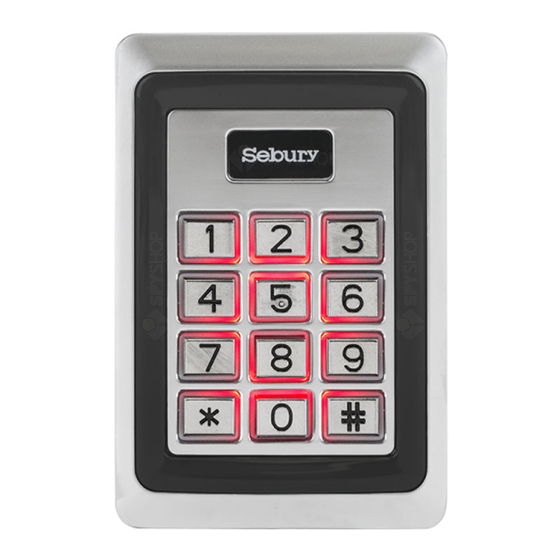
Table of Contents
Advertisement
Quick Links
Instruction ManualV1.0
mKey access control
1 Product overview
1.1 Product introduction
This product uses high-strength zinc alloy body, Proximity card (EM card, also known as ID card)
or password to open the door, built-in highly integrated microcontroller, simple circuit, safe and
reliable, economical and durable, suitable for office, villa etc.
1.2 Features
> 1000 user cards bound with 1000 user passwords, and the user can modify password by himself
> Opening door modes: card, card + PIN, card or PIN, PIN.
> Opening time: 50mS, 1-98 seconds for normal mode, 99 seconds for switch mode;
> Electric lock mode: power-on unlocking (such as electric rim lock, electric strike), power-off
unlocking (such as electric bolt, magnetic lock);
> Built-in high-current MOS tube can directly drive the electric lock, and can resist strong magnetic
unlocking
> Security mode can be set: 10 times invalid card or password will automatically lock the machine
for 10 minutes;
> Can connect with an exit button, convenient to open the door from inside.
Advertisement
Table of Contents

Summary of Contents for Sebury mKey
- Page 1 Instruction ManualV1.0 mKey access control 1 Product overview 1.1 Product introduction This product uses high-strength zinc alloy body, Proximity card (EM card, also known as ID card) or password to open the door, built-in highly integrated microcontroller, simple circuit, safe and reliable, economical and durable, suitable for office, villa etc.
- Page 2 1.3 Functional component 1.4 Technical parameters > Working voltage: DC12±2V > Static current: ≤20mA > Operating current: ≤100mA > Drive electric lock current: ≤3A > Working environment temperature: -20~50°C > Working environment humidity: 0~95% (no condensation) > Maximum card reading distance:5cm 2 (Installation, wiring and Debugging) 2.1 Installation Unscrew the screw on the bottom of the product with the screwdriver, remove the back case of...
- Page 3 2.2Wiring According to the selected wiring diagram, connect the four lead wires to the system cable one by one, and then insert one end of the plug into the 4P socket of the access control, taking care not to short circuit, otherwise the power may be burned out. Please Check and briefly power on to test if the indicator light is normal, and whether the buzzer will beep once, if not please cut off the power immediately, and check the wiring again.
- Page 4 2.3 Debug Power on and test according to the instructions. The debugging will be completed until the lock opened successfully by reading card, password and exit button. 3 Basic functions Operating conventions: > A long sound"Di-"indicates correct operate. Three short sounds"Di Di Di"indicates wrong operate .
- Page 5 3.1 Enter into administrator mode * 6 digit master code # Example, press *888888# to enter into programming mode. 888888 is the default factory master code. Must enter into the programming mode first before undertake the following programming. 3.2 Change the master code new code # new code Example, press 0 999999 # 999999# changed master code to 999999.
- Page 6 3.4.3 Delete all users 2 0000 # * Example, 20000#* 3.5 Setting the working mode 3 0 # card only. 3 1 # card and password. 3 2 # card or password. This is factory default mode. 3 3 # password only. Example, set the working mode to card and password: 3,1#.
- Page 7 3.10.2 Change password by ID number * ID number # old password # new password # new password # Example, Change user’s password by ID number:* 1#123456#111111#111111# Note: when change password by ID number, the old password can’t be initial password 1234. 3.11 Users to open the door Swipe the valid card, or enter 6 digits user passwords, or press the Exit button.
- Page 8 To set door relay time 50ms (1-98)# To set door relay time 1-98s To set to switch mode Tower-on unlock mode Tower-off unlock mode Set to normal mode Set to lock mode 5.Simple Troubleshooting Fault phenomenon Possible reason Exclusion methods Change to qualified power Power voltage too low or too much Unusual Indicator light...














Need help?
Do you have a question about the mKey and is the answer not in the manual?
Questions and answers